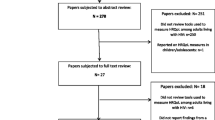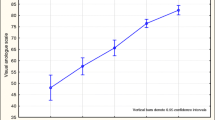Abstract
Information is lacking about the public's perception of the term health-related quality of life (HRQL). Specifically, what are the relations between the domains included in the operational definition of HRQL tools and global health ratings. The purpose of this analysis was to identify factors associated with global rating of HRQL. We conducted a survey of a representative sample of 2,030 Israeli adults, aged 45–75 years. Multiple linear regression analysis was used to identify associations between the dependent variable, the global rating, and socio-economic details, presence of disease states, and each of the domains of the SF-36. The results demonstrate that the model explains only 52% of the variance of the global rating score. The general health domain of the SF-36 explains the vast majority of the variance, 38.5% . Another important explanatory variable was physical functioning domain, which explains 7.0% of the variance and to a lesser extent vitality. The other domains of the SF-36, socio-economic details and presence of disease states contribute only small percentages to the total explained variance of the global ratings of HRQL. It seems that there is a considerable difference between the operational definition of the research community of HRQL and the public perception of this term.
Similar content being viewed by others
References
Gill TM, Feinstein AR. A critical appraisal of the quality of quality of life measurements. JAMA 1994; 272: 619±626.
Lerner DJ, Levine S. Health Related Quality of Life: Origins, gaps, and directions. Adv Med Sociol 1994; 5: 43±65.
Kaplan RM, Bush JW. Health related quality of life measurement for evaluation research and policy anal-ysis. Health Psychol 1982; 1: 61±80.
Patrick DL, Erickson P. Health Status and Health Policy, Quality of Life in Health Care Evaluation and Resource Allocation. New York: Oxford University Press, 1993: p 22.
McDermott W. Absence of indicators of the in¯uence of its physicians on a society's health: Impact of phy-sician care on a society.Am J Med 1981; 70: 833±843.
Torrance GW. Utility approach to measuring Health Related Quality of Life. J Chron Dis 1987; 40: 593±600.
Spitzer WO. State of science 1986: Quality of life and functional status as target variables for research. J Chron Dis 1987; 40: 465±471.
Bergner M. Quality of life, health status and clinical research. Med Care 1989; 27: S148±S156.
Ware JE. Conceptualizing and measuring generic health outcomes. Cancer 1991; 67: S774±S779.
Cunny KA, Perri III M. Single-item vs multiple-item measures of health-related quality of life. Psychol Re-ports 1991; 69: 127±130.
Shmueli A. the SF-36 pro®le and health-related quality of life: an interpretative analysis. Qual Life Res 1998; 7: 187±195.
Epstein-Lewin N, Sagiv-Schifter T, Shabtai EL, Shmueli A. Validation of the SF 36-item shirt-form health survey (Hebrew version) in the adult population of Israel. Med Care, in press.
Ware JE, Snow KK, Kosinski M, Gandek B. SF-36 Health Survey. Manual and Interpretation Guide. The Health Institute, New England Medical Center. Boston, Massachusetts, 1993.
McHorney CA, Ware JE, Raczek AE. TheMOS 36-item Short-Form Health Status Survey (SF-36): II Psycho-metric and clinical tests of validity in measuring physical and mental health constructs. Med Care 1993; 31: 247.
McHorney CA, Ware JE, Lu JFR, Sherbourne CD. The MOS 36-item Short-Form Health Status Survey (SF-36): III Tests of data quality, scaling assumptions and reliability across diverse patients groups. Med Care 1994; 32: 40.
Adams PF, Benson V. Current estimates from the National Health Interview Survey: United States 1990. National Center for Health Statistics. Vital Health Stat 1991; 10: 1±212.
Idler EL, Kasl S. Health perception and survival: do global evaluations of health status really predict mor-tality? J Gerontol 1991; 46: 555±565.
Moum T. Self±assessed health among Norwegian adults. Soc Sci Med 1992; 35: 935±947.
Davies AR, Ware JE. Measuring health preferences in the health insurance experiments. Santa Monica, CA: Rand 1981.
Kraus NM, Jay GM. What do global self-rated health items measure ? Med Care 1994; 32: 930±942.
Varey C, Kahneman D. Experiences extended across time: Evaluation of moments and episodes. J Behav Decis Making 1992; 5: 169±185.
Fredrickson BL, Kahneman D. Duration neglect in retrospective evaluations of a.ective episodes. J Pers Soc Psychol 1993; 65: 45±55.
Author information
Authors and Affiliations
Rights and permissions
About this article
Cite this article
Mozes, B., Maor, Y. & Shmueli, A. Do we know what global ratings of health-related quality of life measure?. Qual Life Res 8, 269–273 (1999). https://doi.org/10.1023/A:1008807419733
Issue Date:
DOI: https://doi.org/10.1023/A:1008807419733




